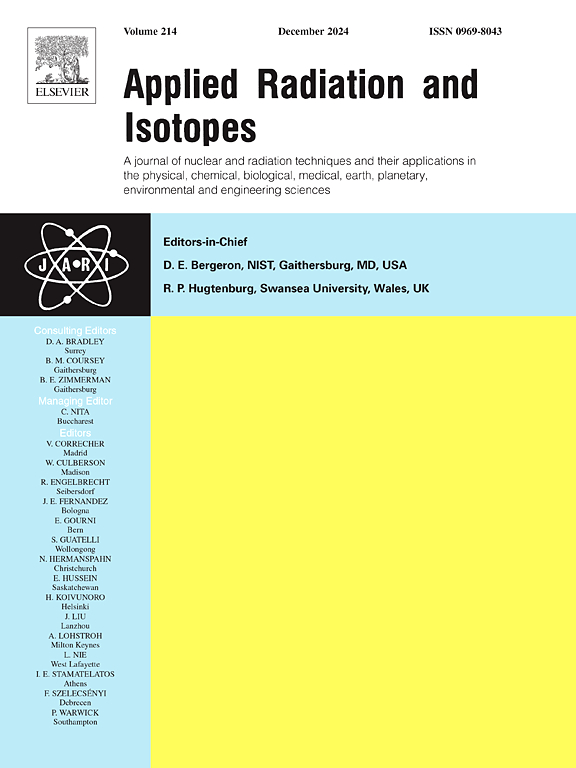Dosimetric evaluation of Rhizophora spp. particleboard bonded with animal protein adhesive at X-ray energies below 100 kVp
IF 1.6
3区 工程技术
Q3 CHEMISTRY, INORGANIC & NUCLEAR
引用次数: 0
Abstract
This research developed a bio-based adhesive (AP) derived from industrial slaughterhouse waste, comprising over 85% protein. The adhesive was characterized by a melting point of 193.14 °C, a neutral pH of 7, and a viscosity comparable to common wood adhesives such as urea-formaldehyde and phenol-formaldehyde. Utilizing this adhesive, a Rhizophora spp. particleboard phantom was produced, featuring wood particles of ≤149 μm, an adhesive concentration of 12%, and a target density of 1 g/cm³, adhering to a standard phantom dimension of 30 cm × 30 cm × 30 cm. The dosimetric properties of this particleboard phantom were subsequently compared with those of water and Perspex phantoms within an X-ray energy range of 60–100 kVp, employing high-sensitivity thermo-luminescent dosimeters (TL–100H). The findings indicated that the percentage depth dose (PDD) values of the AP-Rhizophora spp. particleboard were closely aligned with those of the Perspex and water phantoms, with the greatest discrepancy observed at 60 kVp. Additionally, the half-value layer (HVL) of the particleboard was similar to those of Perspex and water, particularly at diagnostic X-ray energies. These results demonstrate that the AP adhesive is effective for creating Rhizophora spp. particleboard phantoms, exhibiting dosimetric properties comparable to tissue-equivalent materials.
在低于 100 kVp 的 X 射线能量下对使用动物蛋白粘合剂粘合的 Rhizophora spp.
这项研究开发了一种生物基粘合剂(AP),其原料来自工业屠宰场废物,蛋白质含量超过 85%。这种粘合剂的特点是熔点为 193.14 °C,pH 值为 7,粘度与普通木材粘合剂(如脲醛和苯酚甲醛)相当。利用这种粘合剂,我们制作了一个根瘤蚜属刨花板模型,其木质颗粒≤149 μm,粘合剂浓度为 12%,目标密度为 1 g/cm³,粘附在 30 cm × 30 cm × 30 cm 的标准模型尺寸上。随后,在 60-100 kVp 的 X 射线能量范围内,使用高灵敏度热致发光剂量计(TL-100H)将该刨花板模型的剂量特性与水模型和莹石模型的剂量特性进行了比较。研究结果表明,AP-Rhizophora spp.刨花板的深度剂量百分比(PDD)值与莹石模型和水模型的值非常接近,在 60 kVp 时差异最大。此外,刨花板的半值层(HVL)与莹石和水的半值层相似,尤其是在诊断 X 射线能量下。这些结果表明,AP 粘合剂可有效制作根瘤蚜属刨花板模型,其剂量测定特性与组织等效材料相当。
本文章由计算机程序翻译,如有差异,请以英文原文为准。
求助全文
约1分钟内获得全文
求助全文
来源期刊

Applied Radiation and Isotopes
工程技术-核科学技术
CiteScore
3.00
自引率
12.50%
发文量
406
审稿时长
13.5 months
期刊介绍:
Applied Radiation and Isotopes provides a high quality medium for the publication of substantial, original and scientific and technological papers on the development and peaceful application of nuclear, radiation and radionuclide techniques in chemistry, physics, biochemistry, biology, medicine, security, engineering and in the earth, planetary and environmental sciences, all including dosimetry. Nuclear techniques are defined in the broadest sense and both experimental and theoretical papers are welcome. They include the development and use of α- and β-particles, X-rays and γ-rays, neutrons and other nuclear particles and radiations from all sources, including radionuclides, synchrotron sources, cyclotrons and reactors and from the natural environment.
The journal aims to publish papers with significance to an international audience, containing substantial novelty and scientific impact. The Editors reserve the rights to reject, with or without external review, papers that do not meet these criteria.
Papers dealing with radiation processing, i.e., where radiation is used to bring about a biological, chemical or physical change in a material, should be directed to our sister journal Radiation Physics and Chemistry.
 求助内容:
求助内容: 应助结果提醒方式:
应助结果提醒方式:


